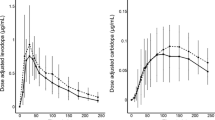Summary
In five levodopa (l-dopa)-treated patients with Parkinson's disease with severe fluctuations of motor performance, plasma l-dopa as well as dopamine levels were measured during 2 days, first under optimal standard l-dopa with peripheral decarboxylase inhibitor (PDI) and then after a dose adjustment period using slow-release l-dopa/benserazide (Madopar HBS) in an open inpatient trial. Three patients benefited from the slow-release preparation; two patients deteriorated with a tendency to have an unpredictable response, a delay to turn “on” with the first dose in the morning, as well as an increase in dyskinesia corresponding to l-dopa cumulation during the day. These problems were subsequently also seen during the follow-up period of 1 year in those patients who benefited from Madopar HBS as inpatients. This might indicate that patient compliance is more difficult with the new formulation. After 1 year all patients had returned to their previous standard l-dopa/PDI treatment. l-Dopa levels continued to fluctuate, but to a lesser degree with Madopar HBS. The equivalent l-dopa dosage had to be increased by 56% (29–100%) with Madopar HBS while mean dopamine levels increased in four patients (by 47–257%) without the occurrence of peripheral side-effects. This implies that with the new formulation more l-dopa is metabolized to dopamine and explains the necessity to increase the equivalent l-dopa dosage.
Similar content being viewed by others
References
Cedarbaum JM, Breck L, Kutt H, Fletcher H, McDowell FH (1987) Controlled-release levodopa/carbidopa. Neurology 37:1607–1612
Curzon G, Friedel J, Grier L, Marsden CD, Parkes JD, Shipley M, Zilkha KJ (1973) Sustained-release levodopa in parkinsonism. Lancet I:781
Da Prada M, Kettler R, Zürcher G, Schaffner R, Haefely WE (1987) Inhibition of decarboxylase and levels of dopa and 3-0-methyldopa: a comparative study on benserazide versus carbidopa in rodents and of Madopar standard versus Madopar HBS in volunteers. Eur Neurol 27 [Suppl 1]:9–20
Dubois B, Danzé F, Pillon B, Cusimanop G, Lhermitte F, Agid Y (1987) Cholinergic-dependent cognitive deficits in Parkinson's disease. Ann Neurol 22:26–30
Eckstein B, Shaw K, Stern G (1973) Sustained-release levodopa in parkinsonism. Lancet I:431–432
Erni W, Held K (1987) The hydrodynamically balanced system: a novel principle of controlled drug release. Eur Neurol 27 [Suppl 1]:21–27
Fischer PA, Baas H (1987) Preliminary experience with Madopar HBS: clinical observations and plasma levodopa concentrations. Eur Neurol 27 [Suppl 1]:81–87
Gancher ST, Nutt JG, Woodward WR (1987) Peripheral pharmacokinetics of levodopa in untreated, stable, and fluctuating parkinsonian patients. Neurology 37:940–944
Goetz CG, Tanner CM, Klawans HL, Shannon KM, Carroll VS (1987) Parkinson's disease and motor fluctuations: long acting carbidopa/levodopa (CR-4-Sinemet). Neurology 37:875–878
Golbe LI, Pae J (1988) Validity of a mailed epidemiological questionnaire and physical self-assessment in Parkinson's disease. Movement Disorders 3:245–254
Gundert-Remy U, Hildebrant R, Stiehl A, Weber E, Zurcher G, Da Prada M (1983) Intestinal absorption of levodopa in man. Eur J Clin Pharmacol 25:69–72
Jensen NO, Dupont E, Hansen E, Mikkelsen B, Mikkelsen BO (1988) A controlled release form of Madopar in parkinsonian patients with advanced disease and marked fluctuations in motor performance. Acta Neurol Scand 77:422–425
Hardie RJ, Malcolm SL, Lees AJ, Stern GM, Allen JG (1986) The pharmacokinetics of intravenous and oral levodopa in patients with Parkinson's disease who exhibit on-off fluctuations. Br J Clin Pharmacol 22:429–436
Kurlan R, Rothfield KP, Woodward WR, Nutt JG, Miller C, Lichter D, Shoulson I (1988) Erratic gastric emptying of levodopa may cause “random” fluctuations of parkinsonian mobility. Neurology 38:419–421
Muenter MD, Sharpless NS, Tyce GM, Darley FL (1977) Patterns of dystonia (“I-D-I” and “D-I-D”) in response to l-dopa therapy for Parkinson's disease. Mayo Clin Proc 52:163–174
Nutt JG, Woodward WR, Carter JH (1986) Clinical and biochemical studies with controlled-release levodopa/carbidopa. Neurology 36:1206–1211
Pezzoli G, Tesei S, Ferrante C, Cossutta E, Zecchinelli A, Scarlato G (1988) Madopar HBS in fluctuating parkinsonian patients: two year treatment. Movement Disorders 3:37–45
Poewe W, Lees AJ, Stern GM (1987) Clinical and pharmacokinetic observations with Madopar HBS in hospitalized patients with Parkinson's disease and motor fluctuations. Eur Neurol 27 [Suppl 1]:93–97
Quinn NP, Parkes JD, Marsden CD (1984) Control of on/off phenomenon by continuous infusion of levodopa. Neurology 34:1131–1136
Quinn NP, Marion MH, Marsden CD (1987) Open study of Madopar HBS, a new formulation of levodopa with Benserazide, in 13 patients with Parkinson's disease and ‘on-off’ fluctuations. Eur Neurol 27 [Suppl 1]:105–113
Rinne UK (1987) Madopar HBS in the long-term treatment of parkinsonian patients with fluctuations in disability. Eur Neurol 27 [Suppl 1]:120–125
Saarinen A, Myllylä VV, Tokola O, Hokkanen E (1978) Effect of a slow release preparation of levodopa on Parkinson's disease in combination with a peripheral decarboxylase inhibitor. Acta Neurol Scand 57:340–349
Sandler M, Goodwin BL, Ruthven CR, Hunter KR, Stern GM (1974) Variation of levodopa metabolism with gastrointestinal absorption site. Lancet I:238–240
Schoppe KJ (1974) Das MLS-Gerät: Ein neuer Testapparat zur Messung feinmotorischer Leistungen. Diagnostica 20:43–46
Shoulson I, Glaubinger GA, Chase TN (1975) On-off response. Neurology 25:1144–1148
Tolosa ES, Martin WE, Cohen HP, Jacobson RL (1975) Pattern of clinical response and plasma dopa levels in Parkinson's disease. Neurology 25:177–183
Webster DD (1968) Critical analysis of the disability in Parkinson's disease. Mod Treat 5:257–282
Weicker H, Ferraudi M, Hägele H, Pluto R (1984) Electrochemical detection of catecholamines in urine and plasma after separation with HPLC. Clin Chim Acta 141:17–25
Woods AC, Glaubiger GA, Chase TN (1973) Sustained-release levodopa. Lancet I:1391
Author information
Authors and Affiliations
Rights and permissions
About this article
Cite this article
Ceballos-Baumann, A.O., von Kummer, R., Eckert, W. et al. Controlled-release levodopa/benserazide (Madopar HBS): clinical observations and levodopa and dopamine plasma concentrations in fluctuating parkinsonian patients. J Neurol 237, 24–28 (1990). https://doi.org/10.1007/BF00319663
Received:
Revised:
Accepted:
Issue Date:
DOI: https://doi.org/10.1007/BF00319663




